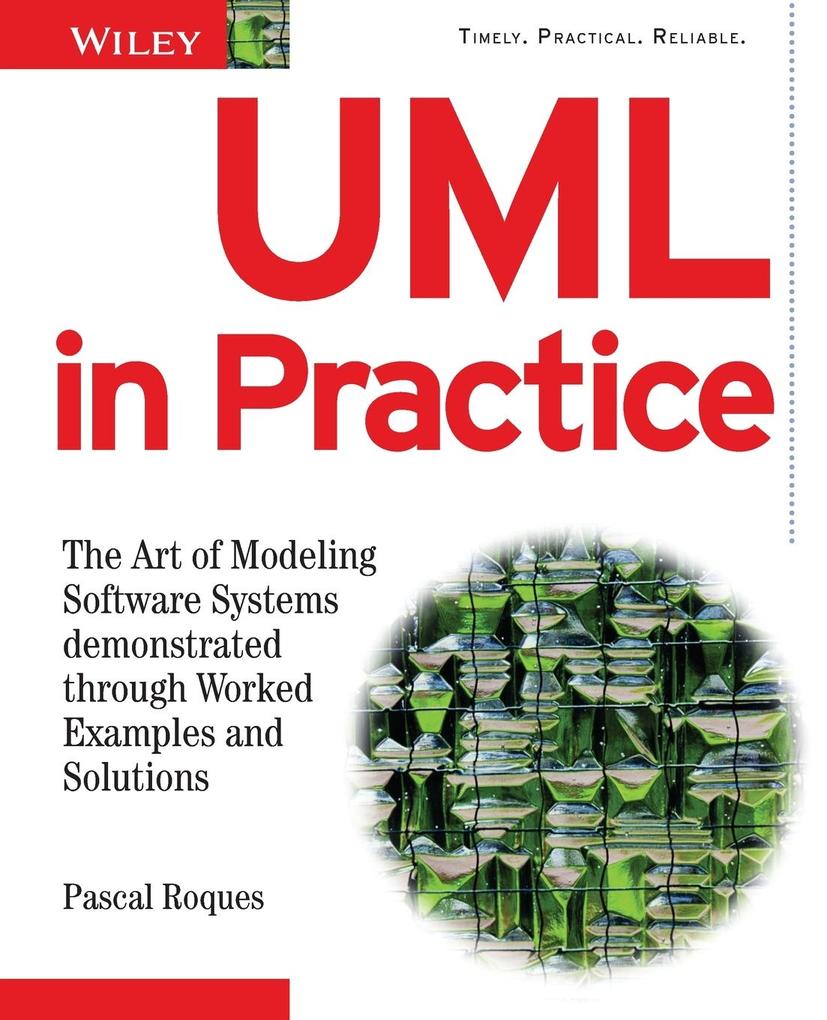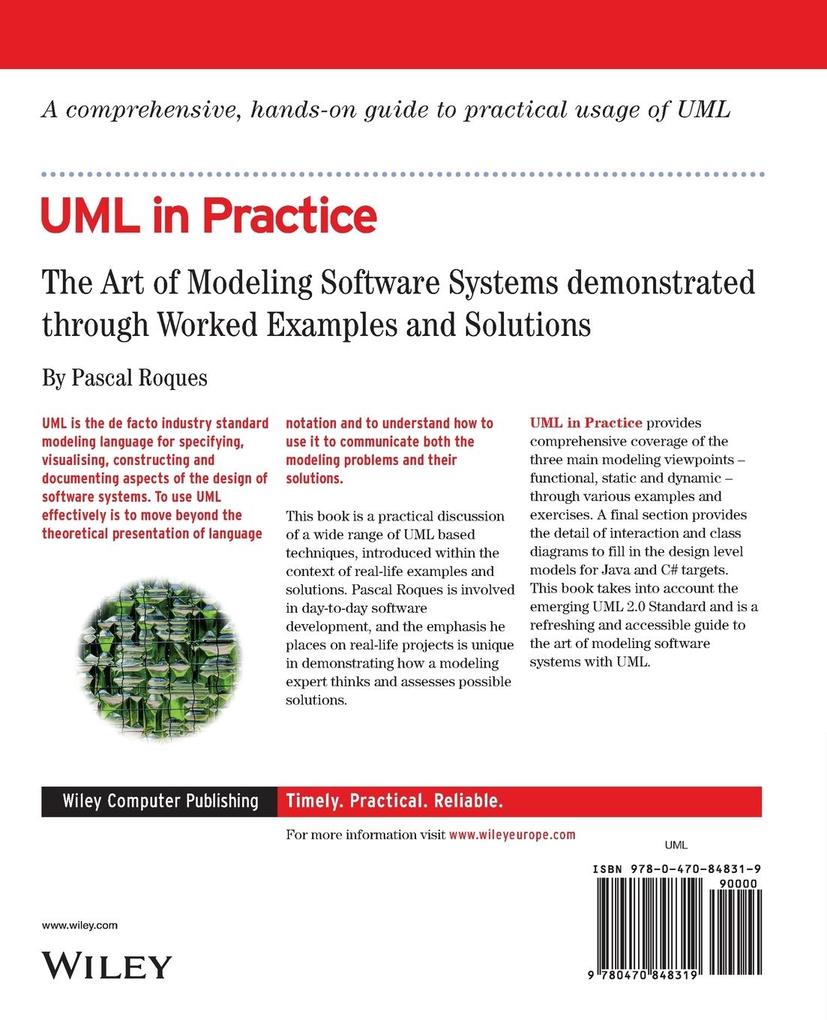
Zustellung: Di, 22.07. - Sa, 26.07.
Versand in 2 Wochen
VersandkostenfreiBestellen & in Filiale abholen:
* Offers comprehensive coverage of all major modeling viewpoints* Provides details of collaboration and class diagrams for filling in the design-level models
Inhaltsverzeichnis
Foreword ix
Introduction xi
Acknowledgements xv
PART 1 FUNCTIONAL VIEW 1
1 Case study: automatic teller machine 3
1. 1 Step 1 - Identifying the actors of the ATM 5
1. 2 Step 2 - Identifying use cases 8
1. 3 Step 3 - Creating use case diagrams 10
1. 4 Step 4 - Textual description of use cases 14
1. 5 Step 5 - Graphical description of use cases 20
1. 6 Step 6 - Organising the use cases 26
2 Complementary exercises 37
2. 1 Step 1 - Business modelling 53
2. 2 Step 2 - Defining system requirements 57
Appendix A: Glossary & tips 65
PART 2 STATIC VIEW 71
3 Case study: flight booking system 73
3. 1 75
3. 2 Step 2 - Modelling sentences 6, 7 and 10 77
3. 3 Step 3 - Modelling sentences 8 and 9 82
3. 4 Step 4 - Modelling sentences 3, 4 and 5 86
3. 5 Step 5 - Adding attributes, constraints and qualifiers 89
3. 6 Step 6 - Using analysis patterns 94
3. 7 Step 7 - Structuring into packages 98
3. 8 Step 8 - Generalisation and re-use 105
4 Complementary exercises 113
Appendix B: Glossary & tips 149
Step 1- Modelling sentences 1 and 2
PART 3 DYNAMIC VIEW 157
5 Case study: coin-operated pay phone 159
5. 1 Step 1 - Identifying the actors and use cases 161
5. 2 Step 2 - Realising the system sequence diagram 164
5. 3 Step 3 - Representing the dynamic context 166
5. 4 Step 4 - In-depth description using a state diagram 168
6 Complementary exercises 185
Apendix C: Glossary & tips 207
PART 4 DESIGN 213
7 Case study: training request 215
7. 1 Step 1 - Defining iterations 217
7. 2 Step 2 - Defining the system architecture 219
7. 3 Step 3 - Defining system operations (iteration 1) 224
7. 4 Step 4 - Operation contracts (iteration 1) 225
7. 5 Step 5 - Interaction diagrams (iteration 1) 228
7. 6 Step 6 - Design class diagrams (iteration 1) 237
7. 7 Step 7 - Defining the system operations (iteration 2) 245
7. 8 Step 8 - Operation contracts (iteration 2) 247
7. 9 Step 9 - Interaction diagrams (iteration 2) 250
7. 10 Step 10 - Design class diagrams (iteration 2) 252
7. 11 Step 11 - Back to architecture 253
7. 12 Step 12 - Transition to Java code 254
7. 13 Step 13 - Putting the application into action 262
8 Complementary exercises 267
Appendix D: Glossary & tips 283
Index 293
Introduction xi
Acknowledgements xv
PART 1 FUNCTIONAL VIEW 1
1 Case study: automatic teller machine 3
1. 1 Step 1 - Identifying the actors of the ATM 5
1. 2 Step 2 - Identifying use cases 8
1. 3 Step 3 - Creating use case diagrams 10
1. 4 Step 4 - Textual description of use cases 14
1. 5 Step 5 - Graphical description of use cases 20
1. 6 Step 6 - Organising the use cases 26
2 Complementary exercises 37
2. 1 Step 1 - Business modelling 53
2. 2 Step 2 - Defining system requirements 57
Appendix A: Glossary & tips 65
PART 2 STATIC VIEW 71
3 Case study: flight booking system 73
3. 1 75
3. 2 Step 2 - Modelling sentences 6, 7 and 10 77
3. 3 Step 3 - Modelling sentences 8 and 9 82
3. 4 Step 4 - Modelling sentences 3, 4 and 5 86
3. 5 Step 5 - Adding attributes, constraints and qualifiers 89
3. 6 Step 6 - Using analysis patterns 94
3. 7 Step 7 - Structuring into packages 98
3. 8 Step 8 - Generalisation and re-use 105
4 Complementary exercises 113
Appendix B: Glossary & tips 149
Step 1- Modelling sentences 1 and 2
PART 3 DYNAMIC VIEW 157
5 Case study: coin-operated pay phone 159
5. 1 Step 1 - Identifying the actors and use cases 161
5. 2 Step 2 - Realising the system sequence diagram 164
5. 3 Step 3 - Representing the dynamic context 166
5. 4 Step 4 - In-depth description using a state diagram 168
6 Complementary exercises 185
Apendix C: Glossary & tips 207
PART 4 DESIGN 213
7 Case study: training request 215
7. 1 Step 1 - Defining iterations 217
7. 2 Step 2 - Defining the system architecture 219
7. 3 Step 3 - Defining system operations (iteration 1) 224
7. 4 Step 4 - Operation contracts (iteration 1) 225
7. 5 Step 5 - Interaction diagrams (iteration 1) 228
7. 6 Step 6 - Design class diagrams (iteration 1) 237
7. 7 Step 7 - Defining the system operations (iteration 2) 245
7. 8 Step 8 - Operation contracts (iteration 2) 247
7. 9 Step 9 - Interaction diagrams (iteration 2) 250
7. 10 Step 10 - Design class diagrams (iteration 2) 252
7. 11 Step 11 - Back to architecture 253
7. 12 Step 12 - Transition to Java code 254
7. 13 Step 13 - Putting the application into action 262
8 Complementary exercises 267
Appendix D: Glossary & tips 283
Index 293
Produktdetails
Erscheinungsdatum
13. Februar 2004
Sprache
englisch
Seitenanzahl
320
Autor/Autorin
Pascal Roques
Verlag/Hersteller
Produktart
kartoniert
Gewicht
653 g
Größe (L/B/H)
236/199/18 mm
ISBN
9780470848319
Entdecken Sie mehr
Bewertungen
0 Bewertungen
Es wurden noch keine Bewertungen abgegeben. Schreiben Sie die erste Bewertung zu "UML in Practice" und helfen Sie damit anderen bei der Kaufentscheidung.










